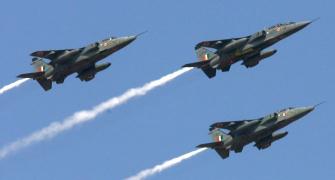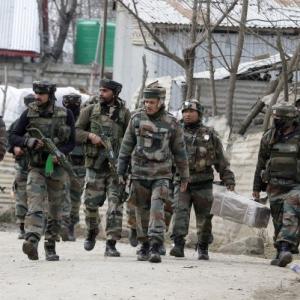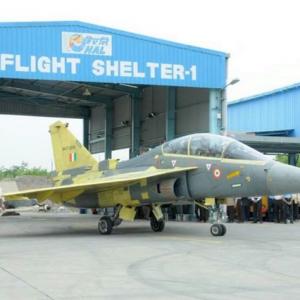'In the case of an India-Pakistan confrontation, the Chinese may undertake more than just posturing, thereby constraining us from deploying adequate forces for decisive results,' warns Brigadier S K Chatterji (retd).

On February 1, 2019, when then interim finance minister Piyush Goyal presented the Interim Budget in Parliament, it appeared that the lessons of the 70-day standoff between Indian and Chinese troops at Doklam in 2018 had faded into the folds of history.
With an allocation of only Rs 431,011 crore ($60.9 billion) to the ministry of defence, the raise is just over 8%. It is barely enough to cover the annual inflation.
Perhaps the response to the Pulwama car bomb and the death of 40 plus CRPF personnel also cannot include deep military options either.
The question that begs answering is: Are we giving modernisation of the defence forces the short shrift, again?
Of the total allocation, Rs 301,866 crore is earmarked for the defence forces. The balance is for the MoD's civil expenditure to include a whooping Rs 108,853 crores for defence pensions.
In the defence budget, the revenue expenditure amounts to Rs 198,486 crore while the capital expenditure amounts to Rs 103,380 crores.
In percentage terms, the maximum increase under any single head is in capital expenditure; a 10% increase over last year's allocations.
This is the amount available to the forces for their modernisation. However, the committed liabilities of procurements already undertaken will need to be paid out of this amount.
It would be prudent to trace in outline the threat scenario that we are faced with when we view the issue of budget for our forces. The Chinese -- with a budget that is three times ours -- are on a modernization drive.
The Chinese are restructuring their forces and equipping them to be decisive in all domains to include land, sea, air, space and cyberspace.
They have undertaken progressive downsizing while pursuing rapid technology advancement. However, while downsizing the army, the Chinese are on a major expansion mode as far as their naval forces and the strength of their marines are concerned.
The PLA Navy, hindered in its operations in the Indian Ocean by having to operate from home bases, is also undertaking fleet expansion and modernisation at a rapid pace. Its fleet has 73 submarines as compared to 16 of ours as per statistics made available by the reputed publication Global Fire Power.
The Chinese are also creating a base in Gwadar, Pakistan. They have a lease on Hambantota, Sri Lanka, for 99 years. They have developed facilities in Kyaukphu port, Myanmar, and are involved in the development of Chittagong port, Bangladesh.
As far as air power is concerned, China is advancing by leaps and bounds. It has developed the Chengdu J 20 aircraft; a 5th generation platform that falls in the category of Lockheed Martin's Raptor F 22 and F 35.
We are as yet looking forward to the Tejas being given final operational clearance and Hindustan Aeronautics Limited ramping up its production line.
In the area of unmanned aerial vehicles, we are miles behind. A similar situation prevails in artificial intelligence, robotics, space and cyberspace capabilities.
The capability enhancement in Tibet is also phenomenal with focused attention on infrastructure, logistics and assets for utilising air power.
To sum up, while we retain adequate defensive capability along our land borders, the Chinese are speedily increasing their offensive capability in Tibet.
As far as Pakistan is concerned, though a manageable threat by itself, the possibility of a collusive threat with China is becoming more and more a reality.
The Chinese are investing $60 billion in Pakistan as part of the China Pakistan Economic Corridor. Should, in a hot war scenario, we impose an adverse situation on Pakistan, the Chinese could well be driven to protect their assets there, or take such steps as would restrain us from exploiting deep gains in Pakistan.
In the defence budget, the army has the lion's share -- 56%, primarily because of its overall size as compared to the other two services. The allocation for the army's capital expenditure is Rs 29,700 crore.
The army is the only one amongst the services to have been provided more than its accumulated commitments of Rs 21,600 crore. However, keeping in view the vice chief's assessment of 68% of its equipment being outdated, the outlay is inadequate to meet modernization needs.
As it stands today, we have not yet started the Future Indian Combat Vehicles programme for our mechanized infantry to shed its obsolescent infantry combat vehicles.
We need to induct almost 2,000 guns. So far, only 145 of the M777 ultra-light howitzers, 100 of the K9 Vajra self propelled 155 mm howitzers and the 114 Dhanush 155mm howitzers have been inducted.
The helicopter fleet requires immediate replacements. Our air defence equipment profile is a serious handicap. If we cannot find the money immediately, we will face serious degradation in our combat capabilities.
The Indian Air Force gets 23% of the defence budget amounting to Rs 68,949 crore. The amount earmarked for capital expenditure is Rs 39,347 crore. This amount is less than the committed liabilities that the air force is scheduled to meet in the current fiscal.
The IAF's status is no better than the army; in fact it can be assessed as even worse. Its current strength of 32 squadrons is 10 squadrons less than the authorised strength.
We have been scouting our for old aircraft in order to arrest the decline in the numbers of squadrons. We will possibly purchase old Mirages from France and mothballed MiG 29 fulcrums from Russia to ease the situation.
The induction of 36 Rafales provides for just two squadrons. It addresses a capability gap rather than the need for numbers.
An RFI (Request For Information) for 114 multi-role fighters has been issued. Six global companies have responded.
The Indian Navy gets 15% or Rs 45,368 crore. The outlay for the navy's capital acquisition is Rs 23,156 crore.
Like the IAF, the funds allotted are inadequate to meet committed liabilities. Expansion and modernisation of the navy is extremely important keeping in view the growing Chinese presence in the Indian Ocean.
The six Kalavari-class (Scorpene) submarines being manufactured at Mazagaon docks are in various stages of manufacture and operationalization. We are yet to find a partner for the next six that are planned to be constructed.
The state of the navy's minesweepers is alarming. A similar situation is encountered on its helicopter and fixed wing assets.
The others who receive funding from the Defence Budget include the DRDO and OFB. The DRDO has been allotted 6% of the defence budget or Rs 18,021 crore. The OFB has been allocated Rs 935 crore.
Obviously, the government is committed to a strong research and development infrastructure to support the Make in India initiative. The need for accountability is a big poser for these organisations.
Overall, the state of our defence preparedness is definitely worrisome. The need to develop capabilities required to face a two front threat with Pakistan and China in consort is becoming more and more a reality now.
The China Pakistan Economic Corridor completely entwines the Pakistan economy with China's own, allowing Pakistan no strategic independence tomorrow.
In the case of an India-Pakistan confrontation, the Chinese may undertake more than just posturing, thereby constraining us from deploying adequate forces for decisive results.
Their economic interests in Pakistan are getting too heavy for Pakistan to sustain unsustainable degradation; be it Pakistan's defence forces, infrastructure, economy or internal situation.
Developing economies generate competing demands, especially when a sizeable population lives beneath the poverty line. Add to it, the subsidies game and generosity displayed in bank loan waivers that we extend across the table leaving ourselves with no means to provide a powered boost to our defence preparedness.
Keeping in view the threats that we face and the pace at which China is modernising its defence forces, there is no alternative to incremental boosting of our defence expenditure by a hefty margin.










